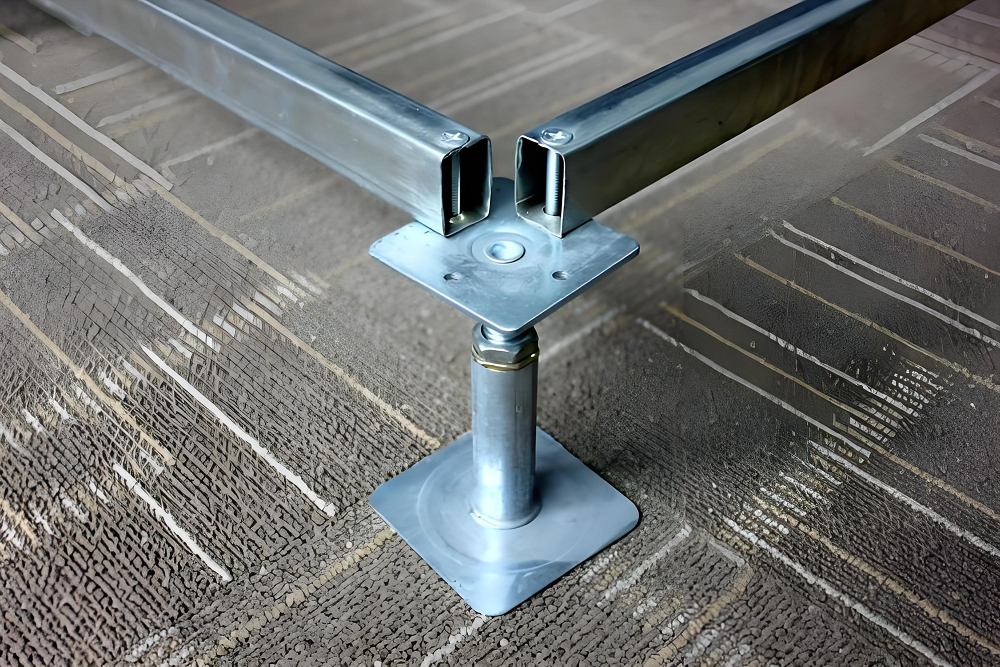NEWS TAG
brand
Why & How To Fix Raised Access Floor Pedestals?
Raised access floors, especially those used in data centers, laboratories, or other specialized environments, require careful installation and maintenance to ensure their long-term reliability. A key component of these floors is the pedestal or bracket system, which supports the floor tiles and helps maintain the floor's stability. Fixing raised access floor pedestals, particularly anti-static or electrostatic types, is essential to prevent issues such as floor warping, shaking, or equipment damage.
In this blog, we'll explain why fixing the pedestals is necessary and discuss how to properly fix them to ensure the safety and functionality of your raised access floor.

Why Fix Raised Access Floor Pedestals?
1. Ensure Stability
The pedestals must be securely fixed to the ground to ensure the stability of the entire raised floor system. If the pedestals are not firmly installed, the floor may shake or become uneven, leading to potential hazards or damage to equipment. Fixing the pedestals ensures that they are in full contact with the ground, providing a stable and level surface.
2. Improve Safety
Unfixed or improperly secured pedestals can pose serious safety risks, especially in high-traffic areas or locations where sensitive equipment is in use, such as data centers. Unstable floor systems may lead to accidents, equipment malfunction, or even injury. Fixing the pedestals mitigates these risks by ensuring that the floor remains stable over time.
3. Professional Installation
To guarantee that pedestals are properly installed, it's essential to have the work done by professionals. They ensure that pedestals are uniformly positioned, stable, and moisture-resistant. Professional installation also ensures that the pedestals are in full contact with the ground and that the floor system is both safe and reliable.
How to Fix Raised Access Floor Pedestals?
Several methods can be used to fix the pedestals effectively, depending on the project requirements and installation environment. Below are the most common fixing methods:
1. Expansion Screw Fixing Method
This method involves driving expansion screws into the ground and using professional tools to secure the pedestals. The base bracket of the pedestal is then connected to the screw, ensuring a firm attachment to the floor.
2. Self-Tapping Screw Fixing Method
Here, self-tapping screws are driven directly into the ground and overlapped with the base bracket of the pedestal. This method is particularly useful when dealing with specific types of flooring materials that can accommodate self-tapping screws.
3. Glue Fixing Method
For some installations, special glue is used to bond the pedestal base firmly to the ground. This method is common when minimal disruption to the subfloor is desired, but it requires the use of high-quality adhesive specifically designed for raised access floors.
The Role of Electrostatic Floor Brackets
Electrostatic floor brackets play a critical role in systems where electrostatic discharge (ESD) must be controlled, such as in server rooms or laboratories. These brackets not only support the floor but also provide a reliable grounding system to prevent the buildup of static electricity.
The brackets are typically made of steel and are installed beneath the floor to offer robust support. They are essential for safely routing cables and providing a stable floor surface for heavy machinery, such as robots in automated environments.
The Installation Process for Electrostatic Floor Brackets
The installation of electrostatic floor brackets requires precision. First, the floor tiles are laid, and any necessary wiring is connected. A groove is then dug around the pedestal to a specific depth, allowing the bracket to be embedded securely. This ensures that the floor tiles remain firmly attached to the brackets, preventing warping or instability.
For environments with mobile equipment, such as robots, the stability of the electrostatic floor bracket is even more critical. Ensuring that enough brackets are installed and that they are evenly spaced is key to maintaining floor stability and performance.
Locking Screws: A Key to Stability
For anti-static raised floors, locking screws are often used to secure the pedestals. These screws provide additional stability, especially for heavier floors. Here are some important considerations when using locking screws:
1. Matching Models
Ensure that the locking screws match the model of the floor bracket. Incorrectly sized screws may not hold the pedestal securely, leading to potential instability.
2. High-Quality Materials
Choose high-quality screws to avoid breakage or damage over time. The durability of the locking screws is crucial to maintaining the floor's integrity.
3. Proper Tightening
Locking screws should be tightened firmly to ensure the pedestal is securely fixed to the ground. This helps prevent future floor movement and ensures long-term stability.
Installation Precautions for Anti-Static Raised Floors
When installing anti-static raised floors, specific precautions must be taken to ensure the installation's success:
Professional Supervision: Always install anti-static floors under the guidance of professionals to ensure that the system is set up correctly and safely.
Pre-Installation Cleaning: Before installation, thoroughly clean the subfloor to ensure it is smooth, flat, and free of debris that could interfere with the installation.
Level Ground: During installation, check that the ground level meets the necessary requirements for a stable floor. Uneven surfaces can cause issues with floor stability over time.
Post-Installation Check: After installation, verify that the floor is even, flat, and securely fixed. Address any irregularities to ensure the quality of the installation.
Fixing raised access floor pedestals is essential to maintain the stability, safety, and functionality of the floor system. Whether you're dealing with anti-static or electrostatic floors, properly securing the pedestals ensures that your floor remains level and safe for long-term use. Make sure to follow professional guidelines, select the appropriate fixing method, and use high-quality materials to ensure the success of your raised floor installation.
